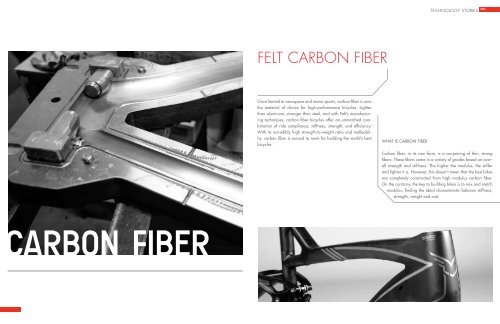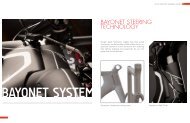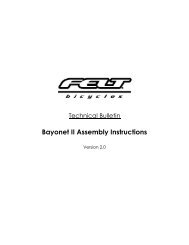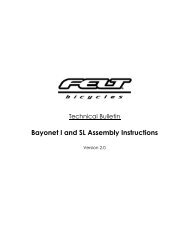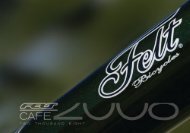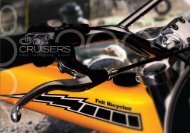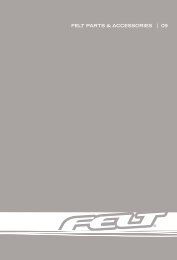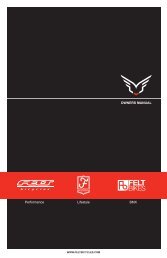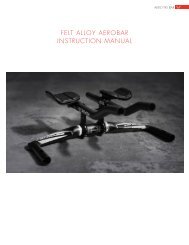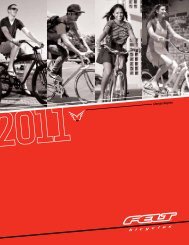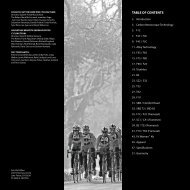You also want an ePaper? Increase the reach of your titles
YUMPU automatically turns print PDFs into web optimized ePapers that Google loves.
TECHNOLOGY STORIES2013<strong>FELT</strong> <strong>CARBON</strong> <strong>FIBER</strong>Once limited to aerospace and motor sports, carbon fiber is nowthe material of choice for high-performance bicycles. Lighterthan aluminum, stronger than steel, and with <strong>Felt</strong>’s manufacturingtechniques, carbon fiber bicycles offer an unmatched combinationof ride compliance, stiffness, strength, and efficiency.With its incredibly high strength-to-weight ratio and malleability,carbon fiber is second to none for building the world’s bestbicycles.WHAT IS <strong>CARBON</strong> <strong>FIBER</strong>Carbon fiber, in its raw form, is a conjoining of thin, strongfibers. These fibers come in a variety of grades based on overallstrength and stiffness. The higher the modulus, the stifferand lighter it is. However, this doesn’t mean that the best bikesare completely constructed from high modulus carbon fiber.On the contrary, the key to building bikes is to mix and matchmodulus, finding the ideal characteristic balance stiffness,strength, weight and cost.Carbon Fiber
TECHNOLOGY STORIES2013UNDERSTANDING UNIDIRECTIONAL <strong>CARBON</strong> <strong>FIBER</strong>To help visualize this, think of a wine glass. If you drop it on a hard floor it shatters because it’s so thin, stiff, and brittle. Now think ofa plastic cup. You can drop it and nothing happens because of its flexible properties. Carbon follows similar rules. As you increasethe modulus, the stiffer and more fragile the fibers become. And if you go in the other direction, the fibers are not as stiff, but morecompliant and durable.FROM <strong>FIBER</strong>S TO FRAMEImagine you’ve been transported to the <strong>Felt</strong> factory floor and are looking over the lay-up schedule for a new F1 road frame. Listedon the piece of paper before you are various instructional entries, each representing an individual piece of carbon fiber. Key metricsinclude dimensions, modulus, fiber orientation, resin content, and fiber areal weight. Together, this information provides the roadSTIFFUnidirectional Carbon Fiber:Maintaining this critical balance is the ongo-YYYHas a high stiffness to weightratio, but is flexible as a sin-ing goal of <strong>Felt</strong>’s team of skilled designersand engineers. Building frames that are sim-gle ply and easily penetrated.ply lighter or stiffer is not enough. Each bikemust deliver the unique ride quality that only<strong>Felt</strong> can deliver.Unidirectional fibers arevery stiff vertically (Y Axis)Unidirectional fibers aremoderately stiff whenbent laterally (Z Axis)Unidirectional fibers arenot stiff when resin isbent laterally (Y Axis)STIFFERUnidirectional carbon fiber responds to stress in very distinct manners. See examples above for an idea.There is no such thing as a bicycle frame constructed completely from high modulus carbon fiber, at least not one that would be safeto ride. It would likely break apart the first time you hit a big enough pot-hole. High modulus carbon fiber can be tricky to work withand there must be balance between stiffness, weight, strength, and durability.Uni. Carbon Fiber layered:Has a high stiffness to weightratio, is stiffer & strongerwhen layered in different orientations.STIFFESTMany Uni. Carbon Fibers layered:Has an ultra high stiffness toweight ratio, is stiff & strongand protected by a carbonfiber weave adding impactprotection.
TECHNOLOGY STORIES2013map that leads to a finished frame. Now imagine hundreds of theseentries, each one slightly different from the next. Quickly you begin tounderstand the complexity of this equation.Many people think all carbon bicycle construction is the same. Though,when you consider all the parameters involved, you realize what a complicatedprocess it really is. Every bike manufacturer can tweak ply orientations,tweak material, and use different resins to hold everythingtogether. But if you don’t put in the time during the design phase to trulyunderstand structural relationships, you’re just creating generic bikes.That’s not what we do at <strong>Felt</strong>.Every frame design behaves differently, and every frame size requires aunique lay-up. The blending of these materials can vary greatly. For example,stiffer fiber plies are typically used in areas requiring maximum performance,such as the bottom bracket and down tube. Higher-strength fiberis best for areas more susceptible to impact. The same attention is appliedto changes in frame size. As tube diameters and intersections change, sowill ply orientation and material specifications. These determinations takemonths, even years to finalize considering all the variations.FEA analysis indicates areas of high stressThe beginnings of a Nine frameOne of many pages that compose a layup scheduleTENSILE STRENGTH v MODULUSTENSILE STRENGTH ksi10507503503060 90MODULUS msiPerforming an in-house torsional stiffness test“When we were in the development phase of the F1, we wentthrough five different lay-up schedules.” explains Jim <strong>Felt</strong>. “Eventhough we’d hit the basic testing numbers we were looking for,it still didn’t ride quite the way we wanted it to. So we kept goingback and tweaking the plies until it had that electric feel.We could have stopped, but that’s not how we operate. It’s thatattention to detail that sets us apart. Our goals are not just abouthitting certain numbers or tolerances or weights. Our goal is tobuild great riding bikes. Every time.”Once the ideal blend of materials and ply orientation is determined,the lay-up schedule is finalized, outlining every detailof the construction process. Finally all specified plies of carbonfiber are ready to be assembled by hand to create a <strong>Felt</strong> frame.Instead, through extensive Computer Aided Design (CAD), Finite ElementAnalysis (FEA), and prototype testing by <strong>Felt</strong>’s professional riders, we areable to ascertain which fiber types to use.The goal is to precisely position each piece on the frame to take maximumadvantage of its specific properties. In some areas, <strong>Felt</strong> uses intermediatemodulus material, because it offers the ideal balance betweenstiffness and strength. In other areas we opt for high modulus materialto take advantage of its high stiffness. Most of the time, these differentmaterials are layered with each other to get the results we’re after.Tests are simulated before actual frames are tested
TECHNOLOGY STORIES2013GOING THE EXTRA MILESome carbon manufacturers use old-fashioned tube-and-lug constructionsimilar to steel lugged frames, where tubes are insertedinto lugs at the intersections and everything is glued together. Whilefacilitating mass production, the problem with this technique is it requiresoverlapping of material, and yields a frame that is overbuilt,heavy and lacking that critical responsive feel.Rather than choose the easiest production methods, <strong>Felt</strong> employs itsown unique manufacturing methods to create frames that meet thehighest quality ride standards.Like MMC, the DMC process starts with sheets of unidirectionalfiber. These sheets can be made from fibers with different levelsof modulus, depending on the intended use of the bike. Somebikes are geared toward competitive racers who require minimalweight and maximum stiffness above all else. Others are forriders seeking maximum performance and durability, and arewilling to sacrifice a few grams.Because the DMC process splits the frame into more specificpieces, we are able to use the most appropriate molding processfor the section being made. For example, the bottom bracketarea and chainstays are molded as one piece. This eliminatesany seams in the chainstays, allowing maximum refinement tothe fiber placement in this critical-to-performance area. This is amuch more time-consuming construction method, however youget better refinement of material and everything stays nice andthin. This enhances ride quality because any time tubes can bekept thin they absorb vibration better and give the frame life.INSIDEOUTModular Monocoque Construction (MMC) is the process used for themajority of <strong>Felt</strong>’s carbon bikes. This advanced manufacturing techniqueallows <strong>Felt</strong> to mold complete major sections of a frameset,and then join them together. Having larger one-piece sections givesdesigners the ability to reduce excess material and optimize eachsection for specific engineering demands.Dynamic Monocoque Construction (DMC) is the process wheresmaller individual sections of the frameset are molded separately,then joined via a proprietary co-molding process. This allows eachframe section to be further optimized for its intended purpose whilekeeping maximum ride quality and performance as a priority.A DA frameset in pieces before assemblyThe Nine frame in various stages of completion.In both MMC and DMC manufacturing <strong>Felt</strong> uses it own proprietaryinternal molding process called InsideOut. By placingpolyurethane inserts inside the frame during the lay-up process,then applying a precise amount of pressure and heat, a frame’sinterior walls can then be formed without any excess resin ormaterial. Once the frame is removed from its mold, so are theinternal PU inserts leaving a smooth, highly refined surface finishinside and out.<strong>FELT</strong> <strong>CARBON</strong> <strong>FIBER</strong> GRADESThere is an adage in the bike building business that says the bestframe material is only the best if it’s used correctly. It’s like twocooks in a kitchen. Each has access to the same ingredients, butonly one knows how to blend the ingredients the best way.The same is true with carbon fiber. Most bike manufacturershave access to a variety of carbon fiber types, and they can allorient those fibers however they see fit. But truly understandinghow to meld these variables is what separates good bikes fromgreat bikes. That’s why <strong>Felt</strong> currently uses three distinct carbonfiber grades.
TECHNOLOGY STORIES2013UHC PERFORMANCE<strong>CARBON</strong> <strong>FIBER</strong> FRAME CONSTRUCTIONIf you want to know why <strong>Felt</strong>’s UHC (Ultra Hybrid Carbon) Performancecarbon fiber is the ideal material for making performance bicycles, simplyconsider the facts:This proprietary blend combines uni-directional structural fiber and aprotective 3k weave, making it stronger than 3/2.5 titanium, stifferthan 6061 aluminum, and less than a quarter the density of steel. Thesefactors combine to allow for the formation of all manner of tube shapeswith near infinite fatigue life.MOLDSMultiple silicone and flexible polyeurethane internalmolds are assembled and used as an ‘armature’. Thinkof it as a temporary surface used to lie the pieces ofcarbon fiber on.LAYUPPrecisely following the layup schedule, the frame makerlays and wraps multiple pieces of unidirectional carbonfiber onto and around the molds. The size and orientaionof each piece plays a monumental role in the frame’sride quality (feel).The materials used in <strong>Felt</strong>’s performance-level carbon fiber bikes are asgood, if not better than many other manufacturers’ top-end models. <strong>Felt</strong>achieves this via a design process where technological development isconstantly being built upon and shared across various bike lines. Thatmeans much of the same technology used on <strong>Felt</strong>’s top-tier F1 framesetis incorporated into all carbon F-Series models. And because of this ongoingcommitment to continually evolve, <strong>Felt</strong> can offer a level of performancethat far exceeds other similarly priced bikes. UHC Performanceframes deliver unmatched durability and the signature <strong>Felt</strong> feel that’sknown throughout the cycling world.<strong>CARBON</strong> <strong>FIBER</strong> WEAVEOnce all the unidirecional carbon fiber has been laid,the entire frame is wrapped in a 1K or 3K weave addingimpact protection.UHC ADVANCEDUHC Advanced is <strong>Felt</strong>’s lightweight, stiff, and durable carbon fiberblend. The higher modulus material in UHC Advanced has an increasedfiber-to-resin ratio, which allows <strong>Felt</strong> engineers to design frames withthin-walled tubing, meaning frames constructed with this material areon average about 20% lighter than their UHC Performance counterparts.This is all done without sacrificing strength or stiffness. The result is theideal blend of value and performance for competitive riders or racers.FINISHOnce the carbon fiber has all been laid, it’s timeto remove the flexible silicone inserts, but leavinginternal PU molds during curing process. Thepiece is then placed into large pressurized moldsand heated at a very specific time and temperatureto allow the resin to cure.
TECHNOLOGY STORIES2013Most Upper-Level Competetors’ Carbon Fiber Frames+ + =Unidirectional carbonfiber (intermediatemodulus)Resin(binds pliesof carbon fiber)More resin**Resin, though used as a bonding agent,adds weight and too much ofit deadens the frame robbing the bikeof ride quality the carbon fiber provided.(All purpose ‘performance’ carbon fiber)MODERATEWEIGHT<strong>Felt</strong>’s UHC Performance Carbon Fiber++=Unidirectional carbonfiber (intermediatemodulus)Carbon fiber weaveoutermost ply(adds impact protection)Resin (prepregnated)(binds plies of carbon fiber)(All purpose performance carbon fiber)LIGHTWEIGHT<strong>Felt</strong>’s UHC Advanced Carbon Fiber++ +=Unidirectional carbonfiber (intermediatemodulus)Additional plies ofHigh Modulus carbon fiber(adds stiffness and is lighter)3 K carbon fiber weaveoutermost ply(adds impact protection)Resin (prepregnated)(binds plies of carbon fiber)(Higher carbon fiber to resin ratio)LIGHTERWEIGHT<strong>Felt</strong>’s UHC Ultimate + Nano Carbon Fiber++ + +=Unidirectional carbonfiber(intermediate modulus)Additional plies ofHigh Modulus carbon fiber(adds stiffness and is lighter)Additional plies ofUltra High Modulus carbonfiber (adds stiffness and islighter)1 K carbon fiber weaveoutermost ply(adds toughness)(Even less resin)(binds and strengthensplies of carbon fiber)Nano Particles(binds and strengthensplies of carbon fiber tocompensate for resinreduction)(Highly-refined light weight carbon fiber)ULTRA-LIGHTWEIGHT
TECHNOLOGY STORIES2013Like any high performance material, UHC Advanced presents some engineeringchallenges. The increased fiber stiffness and reduced weight canalso be more brittle than the UHC Performance blends. Our engineers areinnately aware of the relationship between tube shape and performance,and strive to limit the number of small radii at tube intersections. This not onlyprevents the fibers from fracturing during construction, but also assures thatthe end product is as light, stiff, and strong as it can possibly be.UHC ULTIMATE+NANODuring the frame design process, engineers make specific lay-up decisions based on the forces put into varying areas of the frame,interspersing stiff fibers and durable fibers as needed. But, the real secret to the UHC Ultimate+Nano blend is the proprietary Nanoresin matrix. Most carbon bicycle frames use a standard epoxy resin to bind together individual fibers. <strong>Felt</strong>’s Nano blend requiresless resin, resulting in an overall frame weight reduction.Since Nano resins microscopic particles are elongated instead of round, the bond between resin and fiber is tougher due to theincrease in surface area the Nano particles have with the carbon fiber. This increase in surface area translates to toughness, whichmeans it’s possible to use more high modulus material without losing strength. It is literally a molecular change that yields impressivereal world results.<strong>Felt</strong>’s UHC Ultimate+Nano blend is the ultimate carbon frame building material.The process starts with a quartet of uni-directional carbon fibers: 1) intermediate,2) high modulus 3) ultra high modulus, and 4) 1K weave, whichall work together in perfect unison to provide the ideal blend of stiffness,strength, impact resistance and compliance.“This is what <strong>Felt</strong> is all about. Spending more time for even just a 2-3% gain.” says Jim <strong>Felt</strong>. “We are not worried about making asmany bikes as possible. We are focused on all the extra details that go into making the perfect bike.”


